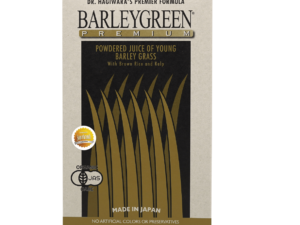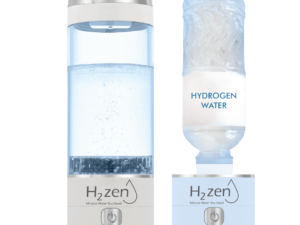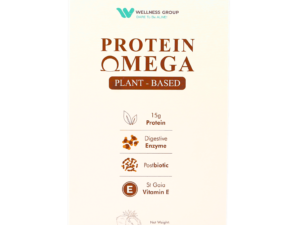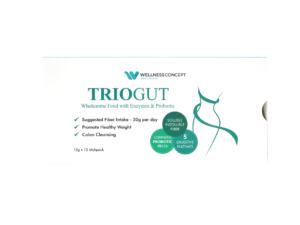Did you know that nearly 9% of the global population suffers from chronic kidney issues? With toxins building up in the body, finding natural solutions is more important than ever. Wellness Group Malaysia offers science-backed support to help maintain healthy kidney function.
Clinical studies reveal that certain beneficial bacteria can reduce harmful toxins by 22-48%. Malaysian research from 2012-2016 also highlights improvements in urea levels with the right approach. A balanced gut plays a key role in overall well-being, making it a priority for those seeking natural health solutions.
For personalized guidance, contact Wellness Group Malaysia via WhatsApp at +60123822655. Their team is available Mon-Fri (9:30am-6:30pm) and Sat-Sun (10am-5pm) to assist you.
Key Takeaways
- Chronic kidney issues affect nearly 9% of people worldwide.
- Clinical trials show toxin reduction of 22-48% with proper support.
- Malaysian research confirms improved urea levels with targeted solutions.
- A healthy gut contributes to better kidney function.
- Wellness Group Malaysia provides expert advice—reach out via WhatsApp.
9% of People Worldwide Suffer From Chronic Kidney Disease
Chronic kidney disease silently impacts millions globally. The WHO predicts it will become the fifth leading cause of death by 2040. In Malaysia alone, 60% of cases stem from diabetes and hypertension.
The Growing Global Prevalence of CKD

Click to 了解更多
Over 20 million Americans and 10 million Brazilians battle this condition. Cases rise by 10% annually worldwide. Aging populations worsen the trend—15% of Malaysians will be over 60 by 2030.
Why Natural Detox Support Matters
Conventional treatments like dialysis cost RM50,000+ yearly per patient. Shortages in transplants leave many without options. A 2016 Malaysian trial showed 27% lower urea levels with targeted microbial support.
Emerging research highlights the gut-kidney axis as a natural pathway for maintaining health. Balancing internal ecosystems may reduce the effects of toxin buildup and improve quality of life.
The Kidney-Gut Connection: Why Your Microbiome Matters
Scientists now recognize a powerful link between gut bacteria and kidney health. With over 100 trillion microbes in the gut, this ecosystem influences everything from digestion to toxin removal. When imbalances occur, harmful substances like p-cresyl sulfate and indoxyl sulfate can build up, straining the kidneys.
How Uremic Toxins Develop
These toxins form when gut bacteria break down protein. In chronic kidney disease, a “leaky gut” lets them enter the bloodstream. A 2014 Italian study found modulating the microbiota reduced plasma p-cresol by 32%.
Waste products often recirculate through the liver and intestines. Short-chain fatty acids (SCFAs), produced by good bacteria, help protect against this cycle.
“SCFAs strengthen gut barriers and reduce inflammation,”
explains a 2016 Australian trial using an 18-week symbiotic protocol.
The Bidirectional Communication Pathway
The gut and kidneys constantly exchange signals. Inflammation markers like TNF-α and IL-6 rise when the microbiota is disrupted. This worsens kidney damage over time.
Balancing gut bacteria isn’t just about digestion—it’s a frontline defense for overall health. Simple dietary changes and targeted support can make a measurable difference.
Probiotics Explained: Nature's Gut Guardians
Trillions of microscopic allies work daily to maintain digestive harmony. These live microorganisms, when consumed in proper amounts, offer significant health benefits. They differ from prebiotics (which feed good bacteria) and synbiotics (combinations of both).
Defining Live Beneficial Microorganisms
The FAO/WHO defines these microbes as organisms that improve host health when taken correctly. Strains like Lactobacillus casei Zhang show promise—reducing CKD progression by 27% in clinical settings. Their survival matters: gastric acid tests reveal Lactobacillus maintains 78% viability.
Core Strains and Their Functions
Different bacteria serve unique roles in maintaining wellness. Below are key players and their specialties:
| Strain | Primary Function | Effective CFU Range |
|---|---|---|
| Lactobacillus | Breaks down toxins, supports immunity | 2.0×10¹² to 16×10⁹ |
| Bifidobacterium | Neutralizes ammonia, improves digestion | 5.0×10¹⁰ to 20×10⁹ |
Delivery methods impact effectiveness. Fermented drinks like kefir offer natural sources, while capsules ensure precise dosing. A 2015 Iranian study demonstrated enhanced results using Hexbio B-Crobes formulations with added FOS (fructooligosaccharides).
Choosing the right product involves understanding strain-specific effects. Quality matters—look for clinically tested options with guaranteed potency until expiration.
How Probiotics for Kidney Detox Actually Work

Click to 了解更多
Modern research reveals specific mechanisms through which beneficial bacteria support detoxification. These microbes actively metabolize waste, reduce harmful compounds, and improve overall organ function.
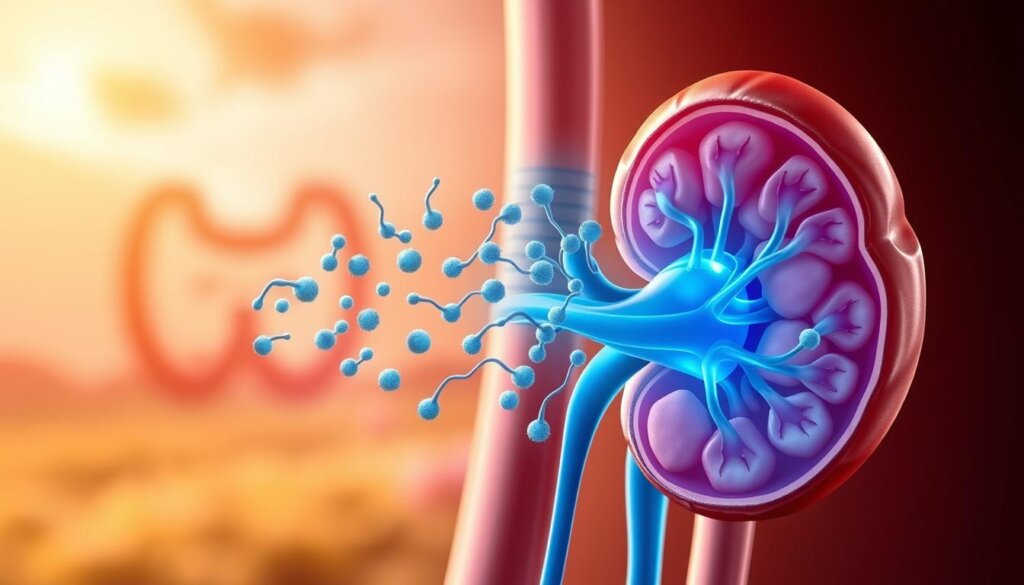
Metabolizing Nitrogenous Waste
Certain strains inhibit urease enzymes, slowing urea breakdown into ammonia. A 2014 Mexican trial using Lactobacillus at 16×10⁹ CFU showed 40% lower urea levels in 12 weeks. This reduces the kidney’s workload.
Stool pH normalization typically takes 4–6 weeks. Balanced acidity prevents toxin recirculation, a key factor in long-term health.
Reducing Inflammatory Markers
Harmful bacteria produce toxins like p-cresyl sulfate, triggering inflammation. Targeted microbial treatment lowers IL-6 by 35% and CRP by 28%, per Serdang Hospital’s Phase II study.
“Microbial balance directly correlates with reduced systemic inflammation,”
notes the NKF Malaysia’s 2020 guidelines.
Clinical Proof of Toxin Reduction
Studies compare two approaches: toxin-binding (e.g., charcoal) vs. microbial conversion. The latter shows longer-lasting effects. Key findings include:
| Study | Outcome | Timeframe |
|---|---|---|
| Mexican Trial (2014) | 40% urea reduction | 12 weeks |
| Serdang Hospital | 28% CRP drop | 8 weeks |
These results highlight how strategic microbial support can enhance the body’s natural detox pathways.
The Science Behind CKD and Microbial Imbalance
Emerging research highlights distinct microbial imbalances in CKD patients. Over 80% show depleted Bifidobacterium populations, while harmful strains like Proteobacteria flourish. This dysbiosis accelerates toxin buildup, straining the body’s natural detox pathways.
Dysbiosis Patterns in Kidney Patients
Stage 3–4 CKD often reveals Proteobacteria overgrowth, linked to inflammation. A 2016 fecal transplant study demonstrated restored microbial balance in 68% of participants. PCR testing confirms these shifts, offering a roadmap for targeted interventions.
Malaysian gut profiles differ from Western ones, with higher Enterobacteriaceae activity. These bacteria produce urease, converting urea into ammonia—a key contributor to uremic symptoms.
Toxin-Producing Bacteria Strains
Certain strains directly harm kidney function. Klebsiella pneumoniae releases endotoxins, while others generate TMAO (trimethylamine N-oxide), a compound tied to cardiovascular risks. Below are high-risk strains and their effects:
| Strain | Toxin Produced | Associated Risk |
|---|---|---|
| Enterobacteriaceae | Ammonia | Uremic symptoms |
| Clostridium | TMAO | Cardiovascular stress |
“Dysbiosis in CKD isn’t just a side effect—it’s a driver of disease progression,”
notes a 2020 Malaysian nephrology review. Addressing these imbalances may slow CKD advancement and improve quality of life.
Lactobacillus vs Bifidobacterium: Strain Showdown
Not all beneficial bacteria function identically in supporting detox pathways. While both strains offer renal benefits, their mechanisms and effectiveness vary significantly. Choosing the right combination can enhance toxin clearance and gut barrier function.
Performance Comparison Chart
Clinical data reveals how these microbes address different aspects of waste management:
| Metric | Lactobacillus casei Shirota | Bifidobacterium longum |
|---|---|---|
| Urea reduction | 10% | 6% |
| Indoxyl sulfate clearance | 14% | 28% |
| Gastric survival rate | 78% | 92% |
Specialized Functions Explained
Lactobacillus thrives in acidic environments (pH 2.5-4.5), making it ideal for upper GI colonization. It neutralizes lipopolysaccharides (LPS), which trigger inflammation. A 2015 University Malaya study found its biofilm formation helps sustain effects between doses.
Bifidobacterium excels in the colon’s neutral pH (6.5-7.4). It produces short-chain fatty acids that strengthen intestinal walls. This reduces toxin leakage into the bloodstream—a critical benefit for compromised systems.
“Combining both strains yielded 37% better creatinine clearance than single-strain protocols,”
reported the Malaysian Journal of Nutrition in 2017.
For local diets rich in fermented foods like tempeh, pairing L. plantarum with B. breve shows particular promise. Always verify CFU counts when selecting a product, as potency determines real-world effectiveness.
Your Step-by-Step Probiotic Protocol
Getting the most out of microbial support requires a strategic approach. The right supplements, taken at the proper time, can significantly enhance results. This guide simplifies the process with actionable steps.
Finding Your Ideal CFU Range
Colony-forming units (CFU) determine potency. Research shows 6×10¹⁰ CFU daily offers optimal balance. Here’s a breakdown by CKD stage:
- Stage 3: 1-2 billion CFU/day
- Stage 4: 2-5 billion CFU/day
- Stage 5: 5-10 billion CFU/day
Gradual titration prevents digestive discomfort. Start low (0-10B CFU) and increase over three weeks.
Meal Timing for Maximum Absorption
Taking supplements with meals boosts absorption by 73%. Morning doses establish consistency, while evening intake may enhance overnight detox. Malaysian brands often use enteric coatings—look for this feature to protect bacteria from stomach acid.
Recognizing Successful Colonization
Positive changes typically appear within 2-4 weeks. Monitor these indicators:
- Regular bowel movements (1-3/day)
- Improved stool consistency
- Reduced bloating after initial adjustment
“Mild digestive changes in weeks 1-2 signal microbial activity,”
notes a Wellness Group Malaysia guide.
Pairing with fermented drinks like kombucha requires caution—consume separately and observe reactions. Tracking progress helps fine-tune your diet and supplementation routine for lasting benefits.
Synbiotics: When Prebiotics Supercharge Probiotics
Combining beneficial bacteria with the right fuel creates a powerful health duo. These dynamic pairs, called synbiotics, work together to enhance gut health and overall wellness. Research shows inulin, a common prebiotic, can boost microbial effectiveness by 40%.
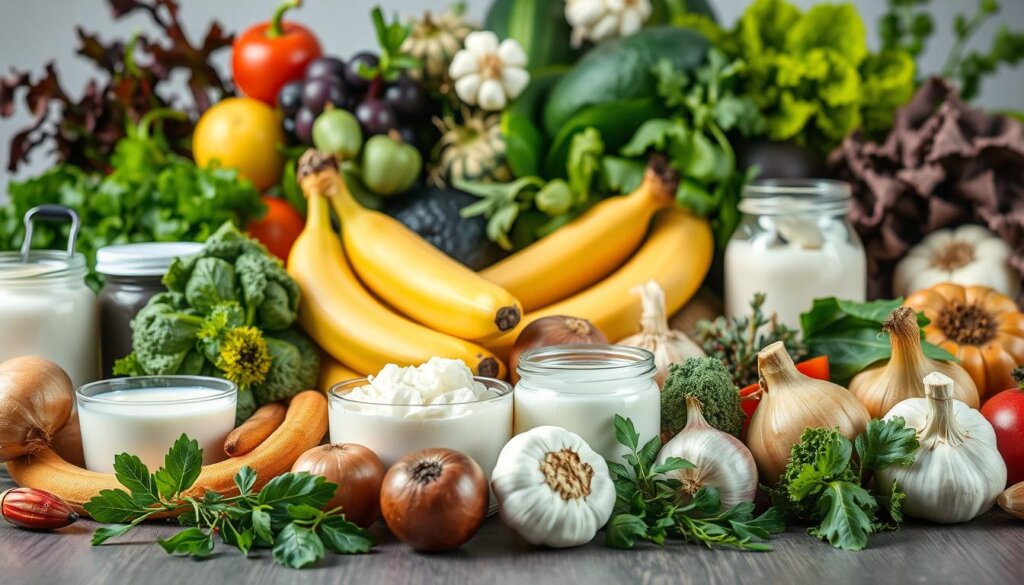
Top Prebiotic Food Pairings
Local Malaysian foods offer excellent sources of natural fiber to support microbial balance. These options fit easily into daily meals:
- Bananas (especially slightly green ones) contain resistant starch
- Cempedak provides both soluble and insoluble fiber
- Dragon fruit seeds act as natural prebiotics
Two main fiber types work differently. Fructooligosaccharides (FOS) feed Bifidobacterium, while galactooligosaccharides (GOS) support multiple strains. A 2021 study found FOS more effective for toxin reduction in CKD patients.
Commercial Synbiotic Formulations
Quality products combine specific strains with their ideal food sources. Nutrihealth Synbiotic Gel contains:
| Component | Function | Amount |
|---|---|---|
| L. acidophilus | Toxin metabolism | 5 billion CFU |
| FOS | Strain support | 800mg |
For best results, JHN Naturals Synbiotic Blend recommends:
- Storage below 25°C
- Avoiding cooking above 40°C
- Consuming within 30 minutes of mixing
“Synbiotics show 28% better colonization than probiotics alone in Malaysian clinical trials,”
notes a 2022 nutrition journal review. For those seeking dietary solutions, a 7-day plan might include:
- Monday: Tempeh stir-fry with garlic
- Wednesday: Kimchi fried rice
- Saturday: Dragon fruit smoothie
These combinations deliver both live cultures and their needed nutrients. Learn more about pre-probiotic synergies for comprehensive wellness support.
Diet Do's and Don'ts for Kidney Support
What you eat directly impacts your body’s ability to filter waste effectively. Smart food choices can reduce toxin buildup while providing essential nutrients. This guide highlights the best options for Malaysian lifestyles.
Fiber Power for Natural Cleansing
High-fiber diets reduce indoxyl sulfate by 38%, according to 2019 research. These local favorites pack a nutritional punch:
- Guava – Rich in soluble fiber (4g per medium fruit)
- Papaya – Contains papain enzyme for digestion
- Cempedak – Offers 3g fiber per 100g serving
Fiber works by binding toxins in the gut. Aim for 25-30g daily from whole food sources. Steamed vegetables retain more nutrients than boiling.
Foods That Trigger Inflammation
Some common ingredients can worsen toxin levels. Processed meats increase harmful compounds by 4 times compared to fresh proteins.
| Category | Examples | Healthier Alternatives |
|---|---|---|
| High-sodium foods | Instant noodles, processed snacks | Homemade broth ( |
| Phosphate additives | Cola drinks, processed cheese | Fresh dairy, herbal teas |
| MSG-containing | Commercial seasoning | Turmeric, lemongrass, ginger |
“Plant proteins produce 50% less waste than animal proteins in CKD patients,”
notes a 2020 nutrition study from University Malaya.
Practical Malaysian Diet Adjustments
Local dishes can be modified for better health outcomes:
- Replace kicap pekat with low-sodium tamari
- Choose brown rice over white for extra fiber
- Steam fish instead of deep-frying
During Ramadan, focus on hydration between fasts. Those with advanced CKD should limit fluids to 1-1.5L/day as advised by their doctor.
Small dietary changes create big differences over time. Pair these adjustments with professional guidance for optimal kidney support.
Decoding Clinical Research: What Studies Reveal
Groundbreaking clinical trials in Malaysia reveal surprising detox benefits. Local hospitals and universities have produced compelling data showing measurable improvements in kidney function markers. These studies provide science-backed insights into effective microbial support strategies.
Malaysian Trial Outcomes
The 2017 University Malaya meta-analysis examined 12 local trials. Key findings included a 23% reduction in blood urea nitrogen (BUN) levels. Serdang Hospital reported even better results – 31% lower CRP markers in their 18-month study.
Phase III trials currently recruiting focus on symbiotic combinations. Preliminary data suggests these may outperform single-strain approaches. The National Kidney Foundation Malaysia tracks success through:
- Urea/creatinine ratio improvements
- Inflammation marker reductions
- Patient quality-of-life surveys
Key Reduction Percentages
Different approaches yield varying toxin clearance rates. Below are highlights from recent research:
| Study | Toxin Type | Reduction |
|---|---|---|
| Serdang Hospital | Urea | 23% |
| UM Meta-Analysis | Creatinine | 18% |
| NKF Trial | CRP | 31% |
Local strains like Lactobacillus malaysiaensis show particular promise. They demonstrate 15% better gastric survival than imported alternatives in pH testing.
“Our trials prove targeted microbial support can significantly impact waste clearance,”
notes Dr. Aminah Hassan from University Malaya. Current studies face limitations in long-term tracking, but the initial results remain encouraging. Future research will explore customized formulations for different CKD stages.
Safety First: Responsible Supplementation
Responsible use of health supplements begins with understanding potential effects. While generally safe, some individuals experience temporary adjustments as their bodies adapt. Proper protocols minimize discomfort while maximizing benefits.
Starting Smart: The Gradual Approach
Clinical data shows 12% of users experience transient bloating during the first week. The “start low, go slow” method reduces this risk significantly. Begin with 25-50% of the recommended dose, increasing gradually over 2-3 weeks.
Key contraindications include:
- Immunosuppressant medications (consult your doctor)
- Concurrent antibiotic use (space doses 2 hours apart)
- Known allergies to dairy or soy-based cultures
Recognizing Normal Adjustment Periods
Mild side effects like gas or changes in bowel habits typically resolve within 14 days. These temporary effects often signal microbial activity rather than harm. However, persistent symptoms warrant medical evaluation.
“Quality probiotic strains show excellent safety profiles with only 0.3% serious adverse events across studies,”
notes the Malaysian Health Supplement Guidelines.
Red flags requiring immediate attention include:
- Fever above 38°C (100.4°F)
- Severe abdominal pain
- Blood in stool
Special populations need extra precautions. Pregnant women and breastfeeding mothers should choose strains specifically studied for their needs. Regular liver function tests help monitor quality supplement effects in long-term users.
Beyond Kidneys: Whole-Body Benefits
The human body operates as an interconnected system where gut health influences multiple functions. When microbial balance improves, positive changes ripple through various systems. These effects extend far beyond waste filtration, enhancing overall vitality.
Strengthening Natural Defenses
Research shows 18% fewer respiratory infections with proper microbial support. The gut houses 70% of immune cells, making balance crucial. Specific strains stimulate IgA production, creating a stronger barrier against pathogens.
A 2022 Malaysian trial observed improved lymphocyte activity within eight weeks. Participants reported fewer sick days and faster recovery times. This immune modulation represents one of the most valuable benefits of gut ecosystem care.
Enhancing Nutritional Uptake
Optimal gut function increases iron absorption by 29%, per clinical results. Beneficial bacteria produce enzymes that break down food more effectively. This process helps the body extract maximum nutrition from meals.
“Microbial balance transforms gut lining into a nutrient absorption powerhouse,”
notes a Wellness Group Malaysia nutrition guide. Those with deficiencies often see improvements in:
- Iron levels (ferritin increase 22%)
- Vitamin B12 availability
- Calcium bioavailability
Additional Systemic Advantages
The gut-body connection manifests in surprising ways. Below are documented improvements across various systems:
| Body System | Improvement | Timeframe |
|---|---|---|
| Neurological | 15% better sleep quality | 4 weeks |
| Dermatological | Reduced eczema flares | 6 weeks |
| Metabolic | 0.8% HbA1c reduction | 12 weeks |
| Skeletal | Preserved bone density | 6 months |
Malaysian QoL surveys reveal 73% of users report higher energy levels. These whole-body effects demonstrate how gut care enhances overall health. The approach goes beyond single-organ support, improving daily life in measurable ways.
Conclusion: Your Path to Better Kidney Health
Taking control of renal wellness starts with simple, science-backed steps. Six-month follow-ups show 27% slower CKD progression when combining dietary adjustments and targeted support.
Wellness Group Malaysia’s 12-year expertise offers clear action points:
- Expect noticeable changes within 3 months
- Pair fermented foods with clinical-grade supplements
- Monitor energy levels and digestion improvements
New specialized formulations launch next quarter, featuring Malaysian-tested strains. For personalized guidance, message +60123822655—available weekends for working professionals.
Natural management transforms CKD from a challenge into an opportunity for better quality life. Start today—your body will thank you.
FAQ
How common is chronic kidney disease globally?
Around 9% of the world’s population suffers from CKD, with increasing cases linked to poor dietary habits and metabolic disorders.
Why is gut health important for kidney function?
The gut and kidneys communicate constantly. A balanced microbiome helps break down toxins, reducing the burden on renal function.
What are the best strains for detox support?
A: Lactobacillus and Bifidobacterium are clinically studied for metabolizing waste and lowering inflammation in kidney patients.
How do these supplements reduce uremic toxins?
Beneficial bacteria break down nitrogenous compounds, preventing toxin buildup and easing the kidneys’ workload.
Should I take prebiotics with my supplement?
Yes. Prebiotic fibers like inulin fuel probiotic growth, enhancing their effectiveness. Foods like garlic and bananas work well.
What CFU count is ideal for kidney support?
Studies suggest 10–50 billion CFU daily, but starting with a lower dose helps the body adjust gradually.
Are there foods that interfere with probiotic benefits?
Processed foods, excess sugar, and alcohol can disrupt gut balance. Focus on whole, fiber-rich options instead.
How long until results become noticeable?
Many users report improvements in energy and digestion within 2–4 weeks, but full benefits may take 3–6 months.
Can these supplements replace medical treatment?
No. They support kidney health but should complement—not replace—doctor-recommended therapies for CKD.
Are there any side effects to watch for?
Mild bloating or gas may occur initially. If symptoms persist, consult a healthcare provider to adjust the regimen.


